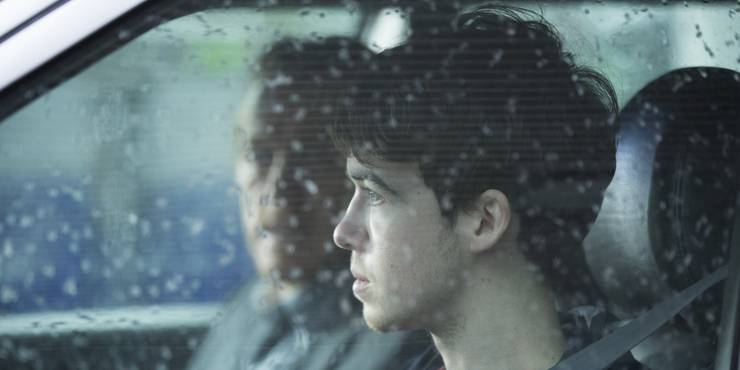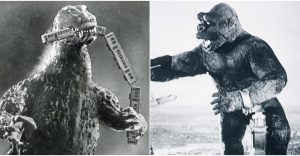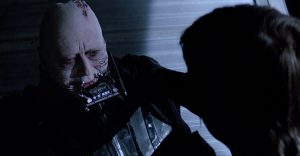15 Most Inappropriate Moments In Netflix Shows

13 Reasons Why (2017) has caused quite a controversy after it appeared on Netflix in April of this year. However, the show (which examines the lives of teenagers after a student kills herself) is not the first Netflix original show to include controversial, insensitive, or graphic depictions of events. Netflix has been forward-thinking with its programming, and has included shows and material that might not be allowed on network television.
The moments included on this list are all from Netflix original television series; both fictional stories and documentary films were considered as long as they were produced by Netflix. Being “inappropriate” does not necessarily translate to bad. In fact, some of these moments are shining moments for Netflix television shows that are willing to push the envelope. However, because of their provocative nature, all of these moments have generated controversy.
Here are the 15 Most Inappropriate Moments in Netflix Shows.
15 13 Reasons Why – Rape Scenes (S1E9 & S1E12)

While much of Netflix’s new show 13 Reasons Why (2017) focuses on the events leading up to and the events directly after Hannah’s suicide, it also contains two depictions of rape scenes in which two different teenage girls are assaulted. Critics and viewers have said that these depictions were potentially triggering for people who suffer from post-traumatic stress disorder. In response, Netflix has included the following message before each of the episodes in question:
“The following episode contains scenes that some viewers may find disturbing and/or may not be suitable for younger audiences, including graphic depictions of rape and sexual assault. Viewer discretion is advised.”
13 Reasons Why was recently renewed for a second season, which will explore the aftermath of the events of the first season. While one of the rape survivors, Hannah, chooses to take her own life, the other, Jessica, is still alive; season two could offer a story of her surviving and healing.
13 Reasons Why is not the only Netflix show to include rape or sexual assault; other harsh depictions include Hemlock Grove (2013) and Orange is the New Black (2013).
14 Hemlock Grove – Werewolf Transformation (S1E2)

In the second episode of Hemlock Grove (2013), Peter Rumancek transforms into a werewolf. His eyes fall out of his head and the wolf body splits his human body apart as it emerges from within. The transformation is gory and shocking, so much so that it caused a bit of a media buzz for the Netflix horror show. While there are a number of moments that are violent or shocking in Hemlock Grove (from the incestuous rape compelled by hypnotism to Peter’s face being eaten off to the mother-son kiss that turns into a bloody tongue extraction), the werewolf transformation set the tone early in the series.
Additionally, Hemlock Grove took a typical transformation sequence that is often repeated in werewolf stories and made it into something horrifying, graphic, and painful. The sequence was largely praised for this dramatic choice. The gruesome portrayal perfectly emphasizes Peter’s emotional and physical torment in becoming a wolf.
13 House of Cards – Frank Spits on Christ (S3E4)

Kevin Spacey’s Frank Underwood has done a number of despicable things on the political drama House of Cards (2013). Along the way to becoming the President of the United States, Frank also became responsible for multiple murders, threatened people in cruel and unusual ways, and even pissed on his own father’s grave. All in all, Frank has a flair of the dramatic, which he employs in all of his violent and perverse exploits.
However, there was a singular action that stirred quite a bit of controversy in the third season, specifically from religious communities. In one scene, Underwood spit on a statue of Jesus Christ in a church. Multiple Christian organizations and church leaders spoke out, saying that the sequence was unnecessary, offensive, and even sacriligious. Even some non-Christian individuals argued that the show overstepped, and some critics felt that it painted Underwood as a cartoonish villain without any boundaries.
12 Grace and Frankie – Grace & Frankie give vibrators to a church group (S3E3)

Grace and Frankie (2015) is show about two women (Jane Fonda and Lily Tomlin) whose husbands leave them… for each other. The buddy comedy that ensues is when this platonic odd couple ends up living together as roommates at their joint vacation home. During the second season, the two have bonded over their shared experience and even become friends. One of their friends gives Grace a vibrator as a parting gift, and Grace ends up hurting her wrist while taking it for a spin. Not deterred, Grace and Frankie decide to go into business creating a vibrator designed for older women.
Much of season three focuses on their resulting company, Vybrant, trying to build a consumer base. In one encounter, Grace and Frankie invite a friend and her “group” to test-run their product. The group, however, turns out to be a church group. At first, the members of the group are offended and leave, but it turns out that they are all interested in the product privately. Grace and Frankie has worked to explore the taboos of senior sexuality, and the third season embraces this to the fullest.
11 Sense8 – “orgy” scene (S1E6)

Sense8 (2015) is the Wachowski sisters’ (The Matrix, Cloud Atlas, Jupiter Ascending) newest television show. It follows eight strangers from all over the globe who suddenly develop a mysterious mental-emotional connection. The first season is largely an exploration of how these distant lives become entangled… and perhaps unsurprisingly, one of those ways is sexually. Sense8 does not shy away from taboo issues and uses its diverse cast to explore a number of social issues, identities, and prejudices. However, the group sex scene, was one of the most highly publicized moments in the first season. When two of the “sensates” have sex with their partners at the same time, three more join in on the sensual experience. The resulting montage is very not safe for work.
However, some television critics also pointed out that the incorporation of the group sex scene was groundbreaking because it included multiple characters (Will, the Chicago cop, and Wolfgang, the safecracker from Berlin) who hadn’t been portrayed as interested in men, joining in on the fun without letting their macho attitudes stop them.
10 A Series of Unfortunate Events – Count Olaf’s Predatory Nature (S1E2)

Based on the bestselling childrens’ books, A Series of Unfortunate Events (2017) rights much of the wrongs of the previous film of the same name (2004). While the television show is full of tales of woe and gloom, it still has a certain charm to it that would capture the imaginations of young (dark) minds. However, in the second episode of the eight episode first season, there is one moment that seems much more disturbing than the rest. Count Olaf’s plot for getting the Baudelaire fortune is marrying the 14-year-old Violet (in a tricky theatrical performance turned reality). The plot is absolutely absurd, but in the twisted world of A Series of Unfortunate Events at least, it would actually work.
The idea of a guardian marrying a child already carries with it the connotation of sexual abuse. However, in the episode that revolves around the marriage (season 1, episode 2), this idea is re-enforced. Klaus tells Count Olaf that he will never be able to touch the Baudelaire fortune; in response, Count Olaf puts his hand on Violet and says, “I can touch whatever I want!“
9 Bojack Horseman – Sextina’s Abortion Song (S3E6)

The premise of Bojack Horseman (2014) might be surprising given its colorful cast of cartoon animals. The show explores the (miserable) life of a former television star who is grappling with his abusive childhood and substance addictions. While Bojack has never shied away from controversial topics, in the third season, one of the episodes focuses on abortion… and in a metafictional way, the controversy around abortion.
In the episode, the teenage musical sensation Sextina Aquafina has decided to live broadcast her abortion and drop a single about her experience. (As it turns out, Sextina isn’t actually the one getting an abortion; instead, Diane, who is voiced by Alison Brie, is the one getting an abortion, but that isn’t really important other than the additional level of absurdity.) The lyrics of Sextina’s single “Get That Fetus, Kill That Fetus” are as follows: “I’m a babykiller / baby-killing makes me horny… I hope and pray to God my little fetus has a soul / because I want it to feel pain when I eject it from my hole” before she goes into a number of dolphin sounds and calls.
8 Narcos – Pablo Blows Up Avianca Flight 203 (S1E6)

Narcos (2015) follows the real life story of the Colombian drug dealer and billionaire Pablo Escobar. As most people are already aware, Pablo Escobar was responsible for some gruesome murders, political assassinations, and brutal executions. There was a time that he was the kingpin of the largest drug operation in the world, and the only way for him to stay on top was through the deaths of his enemies. One of the most chilling moments in the show takes place in the first season. In an attempt to kill presidential candidate César Gaviria (who hoped to extradite Escobar to the United States), Pablo Escobar gave an unknowing young man a suitcase with a bomb in it. While Gaviria was tipped off and escaped the explosion, all 107 people on the plane were killed, along with another three people on the ground.
Of course, perhaps the most terrifying thing about this moment in Narcos is that it is a historical event. It is unknown, however, whether or not the person who brought the explosives onto the plane knew the contents of the briefcase; in this case, Narcos made a choice to portray the new recruit as unknowing.
7 Lady Dynamite – Bam Bam Child Soldiers (S1E11)

Lady Dynamite‘s (2016) first season was a comedy that focused on living with bipolar disorder. The surrealist and playful tone of the show was praised by critics, many of whom compared it to the CW’s Crazy Ex-Girlfriend (2015). However, in the penultimate episode of the first season, the main character, Maria Bamford, becomes the center of attention for a surprisingly dark reason. It turns out that her manager created 10,000 shirts that say “Bam! Bam!” on them with Maria’s face; realizing that Maria didn’t have any interest in them, he sent them to Africa… where they became the shirts worn by child soldiers in South Sudan. Suddenly, Maria is thrown into the spotlight for the wrong reason, and rumors about her being involved with the army in South Sudan run wild in the media.
Maria laments: “People are saying mean things about me on social media. And perhaps more importantly, children are dying.” While Lady Dynamite has always embraced serious topics for the sake of humor, the use of child soldiers in Sudan feels pretty extreme.
6 Black Mirror – Shut Up and Dance Reveal (S3E3)

Black Mirror (2011) began on Channel 4 in the United Kingdom, where it aired two seasons. Netflix commissioned the third and fourth season in 2015. The show explores technological horrors in near futures or alternative universes, with each episode acting as a stand-alone story. One of the most talked about and one of the darkest episodes of Black Mirror is “Shut Up and Dance”, which aired on Netflix is 2016. This episode focuses on a young man who is blackmailed by a mysterious person (or organization?). This person has a video of the young man masturbating, and threatens to expose him if he does not follow their directions. In an effort to prevent the video from being shown, the young man delivers a package, robs a bank, and fights another person who is also under the thumb of the mysterious organization.
While it is alluded to as a possibility previously, in the final moments of the episode, it is revealed that the young man was looking at child pornography. This was a twist that shocked and upset viewers, as the story made him appear to be a sympathetic character. Arguably, of course, that was the whole point.
5 Hot Girls Wanted: Turned On – Videos allegedly used without consent (S1E6)

The award-winning documentary film Hot Girls Wanted (2015) and the subsequent Netflix series Hot Girls Wanted: Turned On (2017) examine pornography and the young women who perform in pornographic films. However, since the six part documentary series aired in April, it has had some controversy around using footage without proper consent. In one case, one of the women who was interviewed claims that while she signed a consent form before being interviewed, after the interview was completed, she felt it was too personal and asked for the footage to not be used. However, her interviews still appear in the film. In another case, two performers had video footage used of them, taken from their Periscope accounts. This footage was used in a montage in the sixth episode. The two performers were never contacted for permission, and the producers of Hot Girls Wanted claim that the clips fall under fair use of video that was in the public domain.
4 The OA – School Shooting Finale (S1E8)

The OA (2016) finished its first eight-episode season with a perplexing finale. The OA (aka Prairie, played by Brit Marling) realizes that she has been seeing visions of a school shooting and rushes to the local school along with her band of misfits. The group ends up facing off with a school shooter (whose face is purposefully obscured) – by dancing? “The Movements” that they perform are supposed to open a portal between dimensions, but it actually just distracts the shooter for long enough that someone is able to tackle and subdue him. Critics and viewers who made it through the show’s confusing and whimsical episodes were still surprised by this absurdist turn of events. Some people even found it offensive, as school shootings are a real and dangerous threat to schools across the country, and though it was likely not the show’s intention, it made it seem as if it was making light of that reality.
3 Unbreakable Kimmy Schmidt – Titus’s Geisha Song (S2E3)

The third episode of the second season of Unbreakable Kimmy Schmidt (2015) falls flat for multiple reasons. One, it purposefully tries to generate controversy by having one of the lead characters, Titus Andromedon, dress as a geisha in his solo show. Two, it is supposed to be a commentary on outrage culture gone too far. A group of Asian activists descend, decrying Titus’s show without seeing it. Is this meant to be a jab at people who didn’t like the portrayal of Dong in Unbreakable Kimmy Schmidt season one? Is this meant to be a larger commentary on outrage on the internet? It’s all muddled, and to add injury to insult, it just isn’t funny.
Additionally, Unbreakable Kimmy Schmidt spends multiple episodes joking about how the “Washington Redskins” shouldn’t be a thing, because it’s incredibly offensive and culturally insensitive. Forget excusing this inappropriate episode – it’s difficult enough to explain why it even makes sense.
2 Orange is the New Black – Poussey’s death (S4E12)

Orange is the New Black (2013) was going to include controversial topics from the beginning. The show explores the lives of the many women in a minimum-security prison in upstate New York. However, in the penultimate episode of the fourth season, Poussey (a fan favorite character) was killed by a prisoner guard, and many fans were upset. Poussey was a black lesbian, and in the year of #KillYourGays, her death was seen as one among many examples of gay characters who were killed. Additionally, it had looked like Poussey could have a happy ending (leaving prison, a loving girlfriend, opportunities!) before she was killed. On the one hand, it is true that Poussey’s death was meant to represent women of color and LGBTQ+ women who suffer violence at the hands of corrupt systems, but some critics believed that her death simply played into the trend that tragic narratives are the only narratives available to women of color and LGBTQ+ women. After the season aired, the hashtag #PousseyDeservedBetter trended on Twitter.
1 13 Reasons Why – Suicide Scene (S1E13)

The season finale of 13 Reasons Why (2017) contains a graphic depiction of a character, Hannah, killing herself. The series has caused a lot of controversy, especially when considering how it portrays suicide. Concerns have ranged from whether or not the story glamorizes suicide (which is to say, after Hannah kills herself everyone finally understands her pain, she is able to revenge herself by attacking those who wronged her, and her love interest obsesses over her). The show has defended its choice to show Hannah’s suicide in detail in the final episode, but many experts (and studies) have shown that portrayals of suicide can lead to real life copycats. Generally, experts who work with people with suicidal ideations recommend handling this material carefully, and 13 Reasons Why did not follow any of the media recommendations that exist around suicide prevention in the production of their suicide scene or over the course of the series as a whole.
If you are experiencing suicidal thoughts, you can always contact the National Suicide Prevention Lifeline at 1-800-273-8255 or text the Crisis Text Line at 741-741.
—
What do you think was the most controversial, shocking, or inappropriate moment in a Netflix original television show? Comment and let us know!
About The Author

















